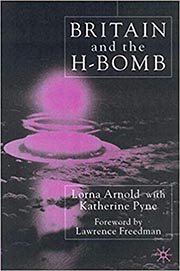Britain and the H-Bomb
by Lorna Arnold, Katherine Pyne (Contributor), Lawrence Freedman
Reviewed January 20, 2004
 The public is well aware of the intense efforts by both the United State's and the Soviet Union to develop atomic, then hydrogen bombs. But Britains' efforts to become the third nuclear power remain largely in the shadows.
The public is well aware of the intense efforts by both the United State's and the Soviet Union to develop atomic, then hydrogen bombs. But Britains' efforts to become the third nuclear power remain largely in the shadows.
The 'fathers' of the United States and Soviet H-bombs are well known, but who is considered the father of the British H-bomb? In the book, Britain and the H-Bomb , Lorna Arnold, the former official historian of the United Kingdom Atomic Energy Authority attempts to uncover the answer to that question. She is assisted by Katherine Pyne, the first technical historian of Aldermaston, Britain's nuclear weapons production plant.
In the book the authors seek to unravel the secrecy and mystery. Arnold was given full access to Aldermaston's records, and the effort was supported by the Ministry of Defence. One of the first real discoveries that is made, is that the historical records of Britain's nuclear efforts are poor and in some cases lost to history. This provided a real challenge to the authors. (One should note that the U.S. weapons labs also suffer a similar problem) The information that was assembles is quite through and should be of great interest to those who enjoyed the detail of Richard Rhodes' Dark Sun: The Making of the Hydrogen Bomb .
This book provides some interesting insight into the motives behind Britain's efforts to develop nuclear weapons. She shows that some felt it was essential for national defense and world peace, while others felt that it was needed for Britain to return to the world stage as a major player.
A major portion of the book is devoted to the 1957-1958 "Grapple" test series conducted at Christmas Island in the Pacific. This series of tests demonstrated Britain's thermonuclear capability. Also chronicled in the book is the rapid development that occurred in their race to develop the bomb. This race was not borne out of a fear of the Soviets, but rather the impending atmospheric test ban treaty.
Also explored is the tense relationship between the U.S. and Britain. Although they had been partners during the Manhattan Project, the passing of the Atomic Energy Act of 1946, severed nuclear relations between the two countries. The restrictions were eased for time, but Britain gained little information from the U.S. efforts. The United States did act on their behalf in stalling the treaty negotiations, to allow for the British to conduct their tests.
This book is a welcomed addition to understanding of the world's development of nuclear weapons.